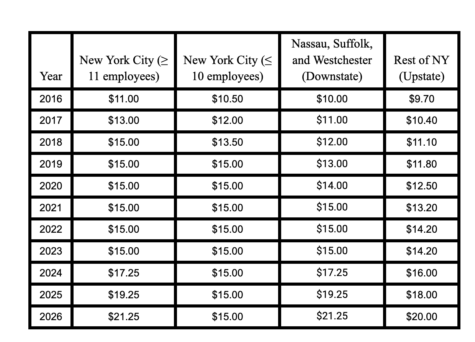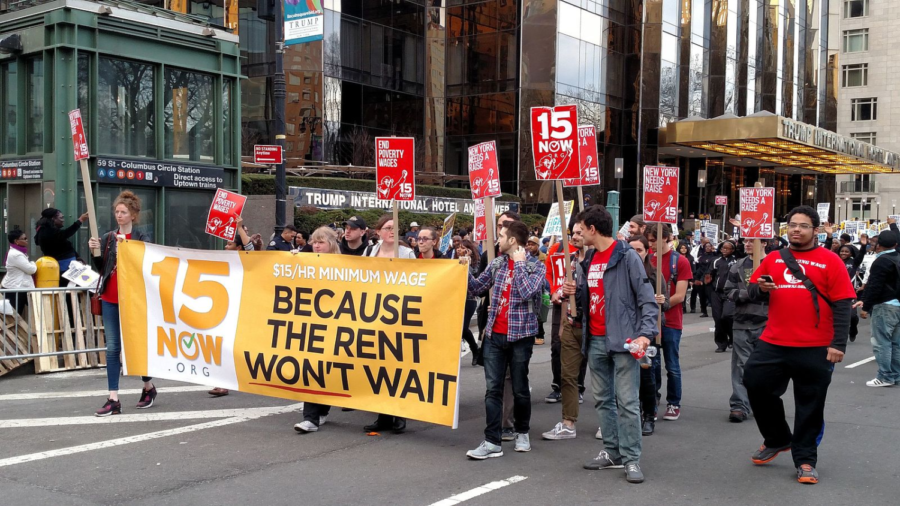What a Minimum Wage Increase Means For New York
How a proposed New York State bill that increases the annual minimum wage could impact housing, employment, and state benefits.
The All-Nite Images from NY, NY, USA, CC BY-SA 2.0
In 2015, protestors marched through New York City’s streets in support of a $15 minimum wage.
When hearing the words “New York” people tend to think of one thing: The City That Never Sleeps. Spanning 309 square miles, this concrete jungle contains 5 boroughs, 59 culturally and economically distinct communities, approximately 1,700 parks, and over 27,000 restaurants. The Big Apple may be a tourist destination for many, but to nearly 9 million residents, New York City is home.
For their entire lives, these residents have had to deal with the extreme prices that come along with being in a popular tourist destination. “To help New Yorkers pay for basic amenities that should be human rights, we must raise the minimum wage. We need to make sure that everyone can live here, not just the wealthy and influential,” said Lydia Du ’24.
To deal with these living costs, the Fight for Fifteen movement was created. It began in 2012 when two hundred New York fast food workers went on strike to advocate against the current $7.25 federal minimum wage. Now, its influence spans over ten states.
The Fight for Fifteen led to a law being passed to raise the minimum wage until New Yorkers all over the state make at least $15 an hour. Six years have passed since this plan was put in place and concerns regarding the minimum wage being insufficient are yet again on the rise.
The “Raise the Wage Act,” officially known as Bill S3062(D), is the proposed solution to this issue. Sponsored by New York State Senator Jessica Ramos, this bill is currently being processed by the Labor Committee.
The plan set out by the bill starts off in January 2024, raising the minimum wage by varying amounts depending on the part of the state. Over the next two years, the minimum wage will be raised by $2 throughout the state. By January 2026, depending on the part of the state, the minimum wage will range from $20.00 to $21.25.

While this is similar to the set increases passed after the Fight for Fifteen, the “Raise the Wage Act” differs because its annual increases will continue past the set increases. These further increases will be in accordance with inflation.
There are two ways to determine if the inflation rate will influence the minimum wage. One is the Consumer Price Index and the other is the Office of Productivity and Technology. The Consumer Price Index tracks the prices paid by urban consumers, whereas the Office of Productivity and Technology tracks the amount of money gained compared to the number of hours worked, also known as labor productivity.
“The minimum wage isn’t proportionate to inflation and the hundreds of other factors that weren’t present or as present in the past,” said Soha Chhapra ’26. These annual increases assure that another six years will pass in which these factors increase while the minimum wage does not.
This type of increase in wages also counters concerns surrounding the minimum wage’s effect on small businesses.
“Traditionally, increases in the minimum wage result in significant and sudden jumps that are difficult for small businesses to plan for,” said Astrid Aune, Senior Advisor to Senator Ramos. “Because our bill includes an annual, gradual increase, small businesses will be able to better plan for small bumps.”
Additionally, these increases will aid in ending New York City’s homelessness crisis. Almost 0.8% of New Yorkers are homeless. In a city of over 8.4 million residents, 0.8% of the population is just short of 70,000 people. This means that New York City alone makes up 8% of the entire country’s approximately 580,000 homeless population.
Most of the time, raising wages usually allows people to afford rent more easily. But, there are exceptions. The study Minimum Wages and Rent: Evidence from U.S. Cities found that in New York specifically, increasing the minimum wage causes a rent increase.
Luckily, the percentage of change in the minimum wage has to be significantly high to cause a jump in rent. In fact, according to the earlier mentioned study, a 10% increase in the minimum wage will cause a 0.8-1.1% increase in rent.
Since the increases in minimum wages will be so low and spread out, its effect on rent will be so low that the majority of New Yorkers will easily be able to handle it. But, a possible solution for the affected minority is to control the amount in which landlords can increase their tenants’ rent after an increase in the minimum wage is implemented.
Another issue arises when it comes to services provided by the state. “Minimum wage should be enough to live without financial support from the government such as food stamps,” said Zoe Levitt ’25.
One of these financial supports is The Supplemental Nutrition Assistance Program, also known as SNAP, a federal program that is widely used by New Yorkers. In fact, in 2021, 2,780,700 New York residents were registered for SNAP. SNAP looks at the number of people in a household and a household’s income to determine its benefits.
A swift increase in wages raises the question of whether the increased wages set by Bill S3062(D) will be enough to supplement the money lost by not receiving aid from SNAP. If a minimum wage worker’s income unexpectedly increases, and they lose their benefits while unprepared, it could affect them negatively.
“What you are referring to is called the benefits cliff,” said Aune, before proceeding to cite the National Employment Law Project report Raising the Minimum Wage Leads to Significant Gains for Workers, Not to ‘Benefit Cliffs.‘
This report details two notable points. Firstly, the majority of minimum wage earners do not qualify for many public benefits at all. Secondly, many of these programs have a gradual phase out.
In gradual phase outs, a household’s earnings are used to slowly reduce the amount of benefits over time. For example, while on SNAP, every dollar increase in earnings causes a 24 to 36 cent decrease in benefits. This ensures that by the time people reach the maximum income for SNAP benefits, they will be nearly fully self-sufficient.
There will always be some who experience the benefits cliff. But, due to the smaller jumps in increases in the minimum wage, most people will just experience a slightly accelerated version of the gradual phase out.
Even though this bill will help alleviate many of the struggles that New Yorkers face, there is always more that can be done. Bill S3062(D) itself states that “across the state, minimum wage workers are disproportionately women and people of color, groups that also face significant barriers to advancement.” This, and plenty of other factors like it, are not directly addressed by an overall change in wages.
“What’s important to realize is that there is no singular cause for racial and gender based economic disparities, and so no one bill is going to close those gaps,” said Aune. Bill S4844(B), which was passed last year, amends Section 206-c of the New York Labor Law to clarify the accommodations nursing mothers must have at work. Another law, Bill S9427(A), makes it necessary for employers to divulge both a job description and compensation for said job description when hiring.
“Bottom line, things are expensive and people deserve to be able to support their families,” said Chhapra. Bill S3062(D) may be just another one of the many steps in making living in New York City sustainable for the average person but it is a vital one.
“The minimum wage isn’t proportionate to inflation and the hundreds of other factors that weren’t present or as present in the past,” said Soha Chhapra ’26.
Lara Adamjee is an Editor-in-Chief for the ‘The Science Survey.’ She enjoys journalistic writing because everyone benefits from it. People read journalism...

